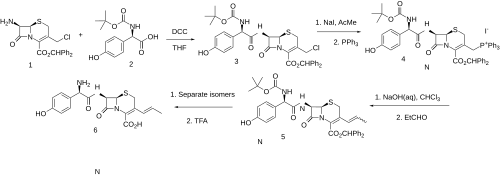Cefprozil
 | |
| Clinical data | |
|---|---|
| Trade names | Cefzil, Cefproz, others |
| Other names | Cefproxil |
| AHFS/Drugs.com | Monograph |
| MedlinePlus | a698022 |
| License data |
|
| Routes of administration | Oral |
| ATC code | |
| Legal status | |
| Legal status |
|
| Pharmacokinetic data | |
| Bioavailability | 95% |
| Protein binding | 36% |
| Elimination half-life | 1.3 hours |
| Identifiers | |
| |
JSmol) | |
| |
| |
| | |
Cefprozil is a second-generation cephalosporin antibiotic.[1] Originally discovered in 1983, and approved in 1992,[2] it was sold under the tradename Cefzil by Bristol Meyers Squibb until 2010 when the brand name version was discontinued.[3] It continues to be available from various companies in its generic form.[4] It is used in the treatment of pharyngitis, tonsillitis, ear infections, acute sinusitis, bacterial exacerbation of chronic bronchitis, and skin and skin structure infections.[5] It is currently available as a tablet and as a liquid suspension.
Adverse effects
Although there is a widely quoted cross-allergy risk of 10% between cephalosporins and penicillin, research has shown no increased risk for cross-allergy for cefprozil and several other second-generation or later cephalosporins.[6] The most common side effects were increased hepatic lab values (including AST and ALGT), dizziness, eosinophilia, diaper rash and superinfection, genital pruritus, vaginitis, diarrhea, nausea, vomiting, and abdominal pain.[5]
Spectrum of bacterial susceptibility and resistance
Currently, bacteria like
Synthesis
This is not a direct copy of Lednicer book like at first glance, but is sourced from the primary reference material.

Displacement of the allylic chloride in intermediate (1) with triphenylphosphine gives the phosphonium salt (2). This functionality is then converted to its ylide; condensation with acetaldehyde then leads to the vinyl derivative (3); deprotection then gives cefprozil. Semisynthetic oral cephalosporin consisting of ~90:10 Z/E isomeric mixture.[12][13]
References
- ^ "Cefzil (cefprozil) dosing, indications, interactions, adverse effects, and more". reference.medscape.com. Retrieved 2021-05-12.
- ISBN 9783527607495.
- National Archives. 11 September 2018.
- ^ "Drugs@FDA: FDA-Approved Drugs". www.accessdata.fda.gov. Retrieved 2022-08-03.
- ^ a b "Cefzil® (CEFPROZIL) Prescribing Facts" (PDF). U.S. Food and Drug Administration. Bristol Myers Squibb.
- PMID 16451776. Archived from the originalon 2012-09-16. Retrieved 2011-02-26.
- ^ "Cefprozil Susceptibility and Resistance Data" (PDF). Retrieved 23 July 2013.
- Bristol-Myers
- Bristol-Myers
- PMID 3624077.
- Bristol-Myers
- PMID 3500158.
- PMID 1080338.
External links
- Cefprozil MedlinePlus Drug Information
